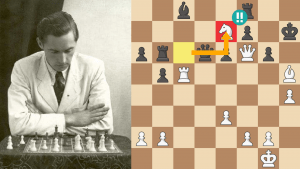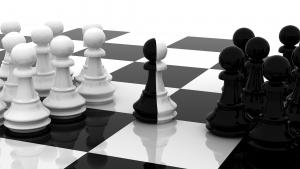
The Curse Of Undefended Pieces
Over the years, I’ve looked at tons of games played by low-rated Chess.com members (games by low-rated players are often extremely instructive). In many instances I see undefended pieces on both sides. And, in many of those games, the defeat was caused by the loss of a piece that was floating in the wind with nothing to protect it.
Yet quite a few of these players ask me about openings or other areas of the game. Little do they know that if they fix this one thing (making sure pieces are protected), they’ll find that their overall results will vastly improve.

I recently saw an amateur game (from an actual tournament) that reached this quiet position:
This example gives us three rules:
- Always make sure your pieces are protected.
- If you must leave a piece without protection, make sure that your opponent can’t take advantage of it.
- Always look to see if your opponent has an undefended piece and, if he does, see if there’s a way to punish it!
Poulp13 (a gentleman from Marseille, France who has a FIDE rating of 1560), asked me what he should do when he has a material advantage.

There are various answers to this, depending on the particular position, or your state of mind. If you’re a piece up, you can use your larger army to overwhelm the opponent. Or, you can simply trade everything off, leaving your opponent stripped of soldiers.
Or you can, at an appropriate moment, sacrifice the extra piece back to simplify the position and enter a winning endgame. Stuff like that. However, Mr. Poulp13 had a particular game in mind. Here is the position after 17.Rb1:
White pretty much ignored Black’s move (17...c4) and tossed his bishop to g5 (18.Bg5). First off, every time your opponent makes a move you should ask, “Why did he do that?” It’s extremely important to understand your opponent’s intentions, and if you fail to do so you risk falling into some sort of unpleasant surprise.
RULE: Do your best to understand every move your opponent makes!
In this case, a bit of a think might lead you to the realisation that ...c5-c4 allows the rook to kick the white queen with ...Rc8-c5. When you notice that, you can stop it cold by 17...c4 18.Be3 when ...Rc5 is no longer in the cards and you can follow up with 19.Bd4 ending any and all threats while simultaneously trading off Black’s most active piece (the f6-bishop).
As you can see, taking a bit of time to understand Black’s 17...c4 pretty much ends the game.
But let’s look at the position in another way:
But let’s look at the position in another way:
In a normal game you should create weaknesses in the enemy camp and then attack them. That same kind of mentality works here too. Just because you are up material doesn’t mean that you should stop improving your position while also weakening your opponent’s. Thus, a glance will tell you that d6 is weak, and that will tell you to play 18.Bf4 when 18...Rfd8 19.Red1 and Black really has no reason to play on.
RULE: Up material? Play like you always play: create weaknesses in the enemy camp and find ways to put pressure on those weaknesses.
Sadly, by failing to understand Black’s 17...c4 White tossed out 18.Bg5?? and after 18...Rc5 Black was able to win a bit of his material back (though he was still lost).
Returning to my earlier example of an undefended piece, you also need to look out for an INADEQUATELY PROTECTED piece. This is when your piece seems to be protected, but in reality is vulnerable to other enemy pieces.
Mr. Poulp13, I gave a lot of advice and rules here, but your number-one priority is to make sure your pieces are protected! If you’re a piece up with a good position to boot, you should easily win simply by making sure, move by move, that all your pieces are protected.
I could end here, but allow me to make use of a position I analyzed in a recent article I wrote (featuring Asmara the Cat, who is also a French player). I am using it again because it’s an absolutely magnificent example of the importance of undefended pieces.
The wonderful example we just looked at should have convinced you to train your brain to scan for undefended pieces in your camp (which will help you avoid many unnecessary losses), while also scanning the opponent’s pieces for the same thing (which will punish your opponents over and over again).






